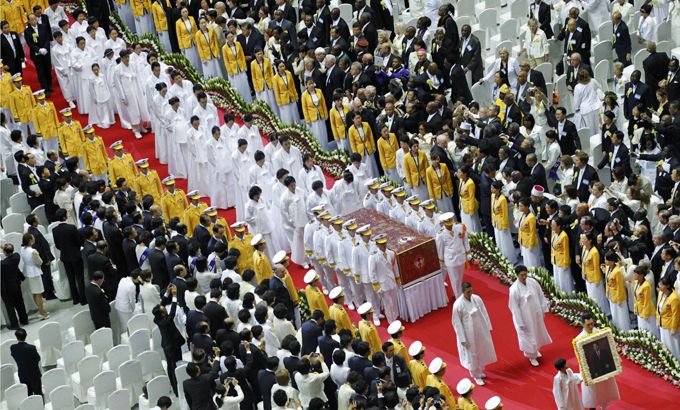South Korean church founder laid to rest
Tens of thousands pay their respects to controversial Unification Church founder Sun Myung Moon who died on September 3.

More than 30,000 mourners have attended the funeral in South Korea of their “saviour”, Unification Church founder Sun Myung Moon.
In a ceremony on Saturday that had all the trappings of a state funeral, Moon’s carved, red-lacquer coffin was carried by men in military-style uniforms into a stadium at the church headquarters in Gapyeong, just east of the capital Seoul.
Moon died on September 3 of complications from pneumonia. His church claims to have three million members.
At a vast, covered arena where the funeral service was held, a giant portrait of Moon stood on a landscaped bank of floral tributes. It was packed to capacity with church members – thousands of whom had flown in from overseas.
Al Jazeera’s Harry Fawcett, reporting from Gapyeong, described the funeral as “emotionally charged”.
Moon’s church, whose members were mocked as “Moonies” by the media, was renowned for its mass weddings of thousands – sometimes tens of thousands – of couples and for its multi-billion-dollar business interests.
Over the past 10 days, more than 150,000 mourners have passed through the stadium to pay their last respects at Moon’s portrait before his burial on a hillside overlooking his church complex.
In his eulogy, heir apparent Hyung Jin Moon, the youngest of his seven sons, pledged to continue the work of the
“true father, saviour and messiah” following his “transition into the spirit world.”
Messiah or cult leader?
Revered by his followers but denounced by critics as a cult-building charlatan who brainwashed church members, Moon was a deeply divisive figure whose shadowy business dealings saw him jailed in the US for falsifying his federal income tax returns.
The teachings of the Unification Church are based on the Bible but with new interpretations, and Moon saw his role as completing the unfulfilled mission of Jesus to restore humanity to a state of “sinless” purity.
“The reason that this has been such a huge event for his people is that Reverend Moon is not just the head of the church,” Fawcett reported.
While it claims a worldwide following of three million, experts suggest the core membership is far smaller although it still carries a commercial clout that allows the church to punch way above its doctrinal weight.
“I’m very sad. As I had been praying a lot for him, I thought he would live longer. But he passed away so suddenly,” Anja Brina, a mourner from Germany, said.
Hur Yuna, 18, whose Japanese and Korean parents married after being personally paired off by Moon, said: “He was the reason for my existence as he coupled my father and mother.”
The church often paired couples from different nationalities with no common culture or language, in the belief that it promoted the universality of mankind and Moon’s teachings.
Rise to prominence
Born to a farming family in 1920 in what is now North Korea, Moon said he had a vision aged 15 in which Jesus asked him to complete his work on Earth.
Rejected by Korean Protestant churches, he founded the Unification Church in 1954 – a year after the Korean War.
As the church rose to prominence in the 1970s and 80s, spreading to the US, it spawned a multi-billion dollar business empire encompassing construction, food, education, the media and even a professional football club.
Moon’s media holdings in the US include the Washington Times newspaper and United Press International news agency, and it also dominates the fishing and distribution industry supplying sushi outlets in the United States.
Throughout his life, Moon assiduously courted political leaders in what critics said was a bid to lend legitimacy to his church which has been condemned as heretical by some Christian organisations.
Without Moon’s unifying presence, some experts see potential for conflict between his sons who control the church’s religious and business arms and who do not command the same loyalty as their father from overseas chapters.